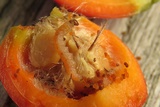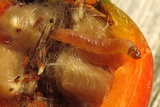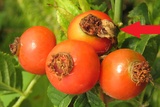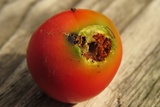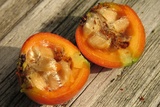Aspila tenebrosana (Duponchel, [1843]) Species
Last modified: Nov. 24, 2025, 7:44 p.m.
A very rare and local species in Belgium.
Details
- Classification
- Family: Tortricidae > Subfamily: Olethreutinae > Tribus: Grapholitini > Genus: Aspila > Species: Aspila tenebrosana
- Vernacular names
- Zwarte rozenbladroller (NL), Deep-brown Piercer, Rose Piercer (EN), Hagebuttenwickler (DE)
- Synonyms
- Aspila roseticolana (Zeller, 1849)
- First mention in Belgium
- De Fré Ch. 1858. Catalogue des Microlépidoptères de la Belgique. — Annales de la Société entomologique belge 2: 45–162. On page 87.
- Status
-
Native
Distribution
Imago
Wingspan 11–14 mm. Forewing dark brown often tinged with purple, short pale costal strigulae with slight plumbeous striae in apical half, weak ocellus with several black streaks and plumbeous edged.
The species can easily be confused with Grapholita funebrana. It is also attracted by the pheromone lures intended for Grapholita funebrana. G. tenebrosana can be separated by the greyish white palps and frons.
Museum specimens
No pictures yet!Specimens in nature
No pictures yet!Bionomics
The larvae feed in August and September on the hips on the host plant. At this time, the infected fruits are often still a bit light green at the top and - unlike most other fruits - often still have one sepal attached to the corolla. The caterpillar's entry hole is usually just below this. There is also a larva of a fly that bores in rose hips (Rhagoletis alternata), but it does not produce grainy frass. Hibernation in a spun hibernaculum just below the surface and pupation next spring in dead wood or under bark. The adults are active in sunshine and at night and come sparsely to light.
Flight periods
The adults have been observed from mid-May towards mid-July.
Observed on
- Host plant (species):
- Rosa canina and Sorbus aucuparia
- Host plant (genera):
- Rosa
The larva feeds mainly on Rosa canina and also in cultivated roses, rarely in fruits of Sorbus aucuparia.
Habitat
It inhabits woodland, gardens, orchards, parks and scrub.

